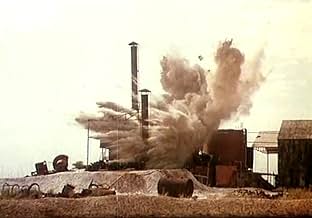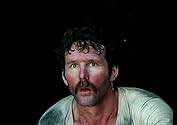Because of a severe drought in Kenya in 1984, ninety thousand starving baboons go on a murderous rampage, killing humans and animals alike.Because of a severe drought in Kenya in 1984, ninety thousand starving baboons go on a murderous rampage, killing humans and animals alike.Because of a severe drought in Kenya in 1984, ninety thousand starving baboons go on a murderous rampage, killing humans and animals alike.
- Director
- Writers
- Stars
Percy Edwards
- Baboon voices
- (voice)
Carl Vundla
- District Officer Tshombe
- (uncredited)
- Director
- Writers
- All cast & crew
- Production, box office & more at IMDbPro
Featured reviews
Michele returned to Hollywood for one final appearance after a short hiatus to raise her son as he was a high school student at the time of the films production.
Michele was excited to travel to Kenya for the filming but was disappointed with its final presentation.
Michele officially retired from acting within days of returning to her home in California.
Michele passed away on November 21st, 2018 at the age of 75 having never returned to her acting career.
Michele was excited to travel to Kenya for the filming but was disappointed with its final presentation.
Michele officially retired from acting within days of returning to her home in California.
Michele passed away on November 21st, 2018 at the age of 75 having never returned to her acting career.
Having spent a large part of my life in Kenya, this film made me afraid to set out into the Tsavo for years. Based on Events that I remember the old people talking about
the film integrates those stories with just the right amount
of fright!! The fear that the drought brought was displayed truthfully in this film. It captures the rugged beauty of the Kenyan countryside and people such as no other films made in Kenya have. If you have a fear of animals, this heightens it!
the film integrates those stories with just the right amount
of fright!! The fear that the drought brought was displayed truthfully in this film. It captures the rugged beauty of the Kenyan countryside and people such as no other films made in Kenya have. If you have a fear of animals, this heightens it!
A ridiculous story of a drought in Africa which results in 90,000 baboons deciding to attack humans as their only way of getting food. Yes, that's right, 90,000 red-assed baboons munch their way through the cast during this silly 97 minute horror flick. There's a fair bit of needless gore, which doesn't help, and lots of build ups which peter out without delivering an exciting or frightening pay-off. The only decent thing about this movie is John Rhys-Davies (who was so great in Raiders of the Lost Ark), who injects a bit of interest in a somewhat underwritten role.
My review was written in April 1986 after watching the film at a Times Square screening room.
Filmed over two years ago in Kenya, "In the Shadow of Kilimanjaro" is an old-fashioned adventure thriller in the borderline horror genre of a last-stand-at-the-house against predators, previously essayed in such films as "Kingdom of the Spiders", "Savage Harvest" and "Roar". Box office outlook is weak.
A famine has caused the 90,000 baboons on a Kenya wildlife reservation to begin banding together an preying on humans (film claims on-screen to be base on a true story, but the 1984 date given is impossible). Wildlife ranger John (Jack to his friends) Ringtree -played by Timothy Bottoms, wants to evacuate the area of about 200 people but the government and manager of the local mine Chris Tucker (John Rhys-Davies) view him as an alarmist and oppose his efforts. As usual in corny horror films like this one, the cast (especially female) is given to wandering alone in the bush long after word of animal attacks has been announced, making them easy prey.
Eventually the danger comes close to home and all survivors huddle together in a hotel run by Michele Carey. The last stand against the marauding animals is successful and a convenient rainstorm spells the end of the drought and the problem.
Hokey film benefits from atmospheric location photography, but suffers from sometimes inaudible dialog recorded in direct sound. Rhys-Davies uses a prop-cigar and a new accent in a fun job as a villain, but by the final reels he has become a true-blue good guy, with only the baboons as hissable targets. Bottoms is merely okay as the bland hero, Irene Miracle is extremely glamorous as his "please come home with met to America" nagging wife (in a role reserved decades ago in these films for Elsa Martinelli) and it's fun to see 1960s starlet Michele Carey again, as the friendly neighborhood hotelier. Leonard Trolley is so hammy as an old British colonial type recalling the good old days that one wishes he had been fed to the baboons early on.
Director Raju Patel substitutes gore effects for suspense in an episodic presentation that fails to knit individual scenes together. Unconvincing matte shots are used to show hundreds of baboons storming down from the hills, while more manageable stagings of a dozen or o animals are used to enact the attacks on humans. Situation inevitably conjures up memories of Cy Endfield's minor 1965 classic "Sands of the Kalahari", but instead of that film's genuinely chilling climax of the baboons descending in long shot on the surviving protagonist (which left the horror to one's imagination), we now get severed limbs, half-eaten faces and torsos and other ineffective gimmicks.
Filmed over two years ago in Kenya, "In the Shadow of Kilimanjaro" is an old-fashioned adventure thriller in the borderline horror genre of a last-stand-at-the-house against predators, previously essayed in such films as "Kingdom of the Spiders", "Savage Harvest" and "Roar". Box office outlook is weak.
A famine has caused the 90,000 baboons on a Kenya wildlife reservation to begin banding together an preying on humans (film claims on-screen to be base on a true story, but the 1984 date given is impossible). Wildlife ranger John (Jack to his friends) Ringtree -played by Timothy Bottoms, wants to evacuate the area of about 200 people but the government and manager of the local mine Chris Tucker (John Rhys-Davies) view him as an alarmist and oppose his efforts. As usual in corny horror films like this one, the cast (especially female) is given to wandering alone in the bush long after word of animal attacks has been announced, making them easy prey.
Eventually the danger comes close to home and all survivors huddle together in a hotel run by Michele Carey. The last stand against the marauding animals is successful and a convenient rainstorm spells the end of the drought and the problem.
Hokey film benefits from atmospheric location photography, but suffers from sometimes inaudible dialog recorded in direct sound. Rhys-Davies uses a prop-cigar and a new accent in a fun job as a villain, but by the final reels he has become a true-blue good guy, with only the baboons as hissable targets. Bottoms is merely okay as the bland hero, Irene Miracle is extremely glamorous as his "please come home with met to America" nagging wife (in a role reserved decades ago in these films for Elsa Martinelli) and it's fun to see 1960s starlet Michele Carey again, as the friendly neighborhood hotelier. Leonard Trolley is so hammy as an old British colonial type recalling the good old days that one wishes he had been fed to the baboons early on.
Director Raju Patel substitutes gore effects for suspense in an episodic presentation that fails to knit individual scenes together. Unconvincing matte shots are used to show hundreds of baboons storming down from the hills, while more manageable stagings of a dozen or o animals are used to enact the attacks on humans. Situation inevitably conjures up memories of Cy Endfield's minor 1965 classic "Sands of the Kalahari", but instead of that film's genuinely chilling climax of the baboons descending in long shot on the surviving protagonist (which left the horror to one's imagination), we now get severed limbs, half-eaten faces and torsos and other ineffective gimmicks.
The basic plot of IN THE SHADOW OF KILIMANJARO (1986) is that an army of crazed, homicidal babboons are killing folks left and right in the middle of nowhere. The thing the filmmakers should of realised is that babboons always look kind of bored. An example comes in one scene where a movie character has a flat tire in the desert. We cut to shots of yawning, pre-occupied looking monkeys watch him from afar. They seem to be saying "Hoo-Hummm, I dunno, should I kill him? I don't know, rather sit here and pick flies off my fur. (Yawn....) Okay. Let me go down and kill 'em." We had a good laugh with this one.
Did you know
- Trivia[Postscript] The film you have just seen is a fictionalized account of a true incident which took place in Africa during the serious drought in 1984. The producers wish to make it known that not a single animal was mistreated during the making of this motion picture. On completion of filming the Baboons were rehabilitated to their natural surroundings. The Baboons were captured under the supervision of the Kenyan Ministry of Tourism and Wildlife from the areas where they had been a nuisance to the local population.
- Crazy credits[Postscript] The film you have just seen is a fictionalized account of a true incident which took place in Africa during the serious drought in 1984. The producers wish to make it known that not a single animal was mistreated during the making of this motion picture. On completion of filming, the Baboons were rehabilitated to their natural surroundings. The Baboons were captured under the supervision of the Kenyan Ministry of Tourism and Wildlife from the areas where they had been a nuisance to the local population.
- ConnectionsFeatured in Trailer Trauma 3: 80s Horrorthon (2017)
- SoundtracksIn the Shadow of the Kilimanjaro
Words and Music by Chieli Minucci & Allan Smallwood
- How long is In the Shadow of Kilimanjaro?Powered by Alexa
Details
- Release date
- Countries of origin
- Language
- Also known as
- Im Schatten des Kilimandscharo
- Filming locations
- Production companies
- See more company credits at IMDbPro
Box office
- Gross US & Canada
- $181,410
- Opening weekend US & Canada
- $181,410
- May 11, 1986
Contribute to this page
Suggest an edit or add missing content



























